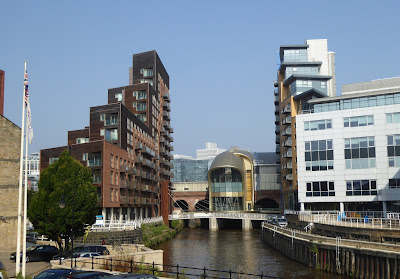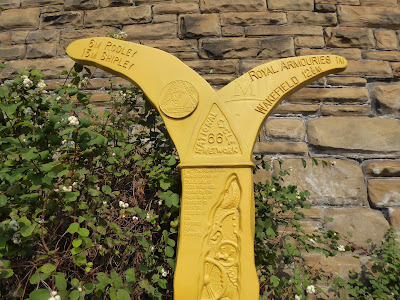
Navigable water once determined the location and growth of towns and cities. The city of Leeds was no exception for it grew from a small market town on the Rive Aire trading wool in the West Riding of Yorkshire to expanding in the boom times of the mills of the Industrial Revolution and trading with the world. Today it is the UK's fourth largest urban economy. Here at Granary Wharf near the city centre the whole area has undergone a massive regeneration since 2009 with residential building, restaurants, hotels, bars etc. The photograph above shows on the left the copper cladding and cedar panels of Waterman's Place apartments. The dome in the middle is the recently completed southern entrance to Leeds Railway station consisting of 2000 pieces of steel which sit on top of the Victorian viaduct of 1869. When you take the path towards the station entrance with its escalators before you get to it the first amazing sight is of the rushing waters of the River Aire cascade down to the left under the viaduct, or what is called locally the 'dark arches'.
But let me take you away from here
past the yarn bombed boat
and away from modernity and continuing along the waterside. This is the short canal that was built by the Aire and Calder Navigation Company to link the riverside industries to the Leeds-Liverpool canal. A lock separates the two waterways
but this is Lock Number 2 - Office Lock, so named because the bridge I am taking this photo from is where the Canal Offices are.
and the mile post tells one how far it will be before reaching Liverpool. A local wag saw me taking a photo of this and dryly said "there will be another one in a mile".
 |
| Millennium Milepost for Route 66 'The Fossil Tree' |
But that is not the only way for we are also on Route 66, unfortunately not the one where one can
"take that California trip", to "get your kicks on Route 66" but a cycle route that crosses England from Manchester on the west side to Hull in the east (Spurn Head) and spends 13 of its 132 miles peddling alongside the canal.
But I'm walking away from Leeds and looking back at the Italianate chimneys of what was the Tower Works whose Victorian owner was so fascinated by Renaissance Italy he built his chimneys in that style. The white modern building is Bridgewater Place, nicknamed locally 'The Dalek'
The canal towpath is also popular with runners so I could not resist a reflecting bridge and a red topped runner photograph, happily despite being a bit slow I got him in the picture.
 |
| St Anne's Ing Lock (Lock 3) |
Canal boating in contrast to cycling and running is languid leisure interspersed with great activity when going through the lock systems (a total of 91 of varying flights on the full stretch of canal).
 |
| Oddy Two Rise Lock (Locks 4 and 5) |
Being an urban area there are splashes of graffiti along the start of the canal, especially where concrete road bridges have been built over it but some are on a different scale altogether
like this funky frog enjoying his canal side view.
An entry to ABC Wednesday, a journey through the alphabet, this week sojourning at L
here








